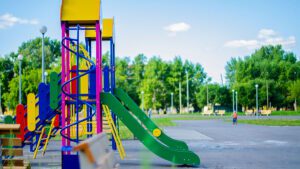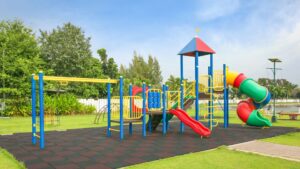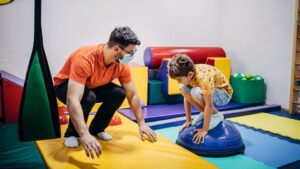Soft play is one of the most popular indoor activities for young children — and for good reason. It’s safe, sensory-rich, and designed to support physical, cognitive and social development. Whether you’re a parent deciding where to take the kids, a nursery manager planning a layout, or a shopping-centre operator evaluating attractions, this guide explains what soft play is, how it benefits children, where it can be installed, and what to consider when choosing equipment.

Quick definition: What is soft play?
Soft play refers to indoor play areas built from padded, cushioned, and child-safe components. Typical elements include foam blocks, ball pits, soft-climb structures, low slides, tunnels, and sensory panels. Everything in a soft play environment is finished in soft vinyl or fabric, machine-stitched for durability, and designed to minimise injury during active play.
Soft play replicates the adventurous aspects of outdoor playgrounds but adapts them for indoor safety, small spaces, and younger age groups. It’s ideal for toddlers and preschoolers, but modern installations often include zones for older children too.

Types of soft play equipment
Soft play comes in many shapes and sizes. Knowing the options helps you choose equipment that matches your space, budget and target age group.
- Ball pits – classic sensory zones filled with plastic balls; great for tactile play.
- Soft blocks & modular sets – foam shapes that kids stack, crawl over and build with.
- Mini slides & ramps – gentle slopes for toddlers to practice climbing and sliding.
- Crawl tunnels & low mazes – encourage exploration and spatial awareness.
- Soft sculpted animals and shapes – themed pieces (dinosaurs, cars, trees) that spark imagination.
- Sensory panels & activity walls – touch, sound and visual stimuli for fine-motor development.
- Multi-level soft play structures – small towers and platforms with soft barriers for preschoolers.
- Integrated role-play areas – market stalls, kitchens and houses made from soft materials.
- Interactive soft-flooring – cushioned surfaces with printed paths or games for organised activities.

Benefits of soft play for children
Soft play is much more than entertainment — it’s a development tool. Here’s how it helps children grow.
1. Physical development (gross and fine motor skills)
Climbing, crawling, jumping and balancing in soft play strengthen large muscle groups. Smaller manipulative tasks — pressing a panel, turning a knob — develop fine motor control and hand-eye coordination.
2. Sensory stimulation
Soft play environments provide multi-sensory input (touch, sight, sound, proprioception). This supports sensory integration, calms overstimulated children, and helps infants and toddlers regulate sleep and mood.
3. Cognitive and problem-solving skills
Choosing routes through a soft-maze, stacking blocks in a tower, or negotiating turn-taking requires planning, sequencing and basic problem solving — early executive-function training disguised as play.
4. Emotional resilience and confidence
Mastering a small climb or a new obstacle builds confidence. Soft play’s low-risk environment encourages children to try again after failure, which fosters persistence and self-efficacy.
5. Social skills and language
Shared spaces encourage interaction: kids learn to negotiate, share, take turns, and build friendships. Role-play areas develop vocabulary and storytelling ability.
Where can soft play be installed?
Soft play is flexible and can be adapted to many venues:
- Nurseries, preschools and daycare centres — daily development-focused play.
- Indoor play centres and family entertainment venues — revenue-driving attractions.
- Shopping centres, cafés and malls — a family-friendly draw that increases dwell time.
- Leisure centres and community halls — structured classes or open play sessions.
- Hospitals and therapy centres — sensory areas to support development and recovery.
- Private homes and estates — smaller bespoke setups for playrooms.
- Restaurants and hotels — family amenities that add value for parents.

Design tips: create a great soft play area
A well-designed soft play area balances fun, safety and operational needs.
- Zoning by age: Separate toddler/tiny-tot areas from preschool or mixed-age zones.
- Clear sightlines: Parents and staff should easily supervise children — avoid visual barriers.
- Durable safety surfacing: Use cushioned floors that are easy to clean and slip-resistant.
- Low-maintenance materials: Choose vinyl covers with reinforced stitching and fire-retardant certification.
- Accessible design: Make pathways wide enough for strollers and wheelchair access where possible.
- Theming & color: Bright, friendly palettes and themed pieces (jungle, ocean, farm) increase engagement.
- Storage & staff areas: Include space for staff, first-aid, cleaning supplies and tidy storage.
- Hygiene planning: Design for frequent cleaning with removable, wipeable covers.

Safety standards and regulations
Compliance is non-negotiable. Soft play operators should follow local safety standards (examples include ASTM, EN 1176/1177 in Europe, and relevant national codes). Key safety practices:
- Buy equipment tested to industry standards.
- Install to manufacturer guidelines and have a professional handover.
- Create a routine inspection and maintenance checklist.
- Train staff on supervision, emergency protocols, and cleaning procedures.
- Post clear age/group rules and capacity limits.

Cleaning and maintenance
Soft play gets heavy use — cleaning is critical for safety and reputation.
- Daily cleaning: Wipe high-touch surfaces, vacuum/dry-mop floors, empty ball pits of debris.
- Weekly deep-clean: Wash ball-pit balls, steam-clean fabric panels where feasible, disinfect sensory panels.
- Regular inspections: Check seams, fasteners, foam core integrity and replace worn components promptly.
- Maintenance log: Track repairs, incidents and cleaning schedules for compliance audits and insurance.
Choosing a supplier or manufacturer
When selecting a soft play supplier, consider:
- Safety certifications and material specs (flame-retardancy, phthalate-free vinyl).
- Custom design capability (themes, bespoke sizing, site-specific engineering).
- Warranty and spare parts policy.
- References and playground portfolio — ask to see installations in operation.
- After-sales service — installation, staff training and maintenance support.
- Sustainability practices — recyclable materials and ethically sourced foam/vinyl.
Request 3–4 quotes and compare not only price but warranty terms, lead time, and included services (installation, onsite training, manuals).
Commercial considerations: ROI & programming ideas
For businesses, soft play is more than an attraction — it’s a source of revenue if positioned correctly.
- Open-play admission (timed sessions) generates steady footfall.
- Private hire & birthday packages are high-margin revenue drivers.
- Classes and workshops (baby sensory, toddler gymnastics, parent-baby yoga) increase weekday occupancy.
- Memberships & loyalty encourage repeat visits.
- Food & retail cross-sales: cafés, gift shops and party extras boost per-visit spend.
- Corporate or school hires expand B2B revenue streams.
Frequently asked questions (short)
Q: What ages use soft play?
A: Primarily 0–6 years for classic soft play; older children can use bigger soft-climb structures when zones are separated.
Q: Are soft play areas hygienic?
A: Yes — with daily cleaning routines and manufacturer-recommended disinfectants, soft play can be hygienic and safe.
Q: How long does equipment last?
A: High-quality soft play, with proper maintenance, can last 7–15+ years. Vinyl covers and foam may need periodic replacement.
Q: Can I install soft play outdoors?
A: Some modular products are weather-resistant, but most soft play is designed for indoor use. Outdoor use needs UV-stable materials and drainage solutions.
Conclusion
Soft play is a powerful blend of safety, sensory stimulation and imaginative fun. It supports early development across physical, cognitive, emotional and social domains while offering flexible installation options for nurseries, retailers and entertainment venues. Whether you’re designing a toddler zone, choosing equipment for a daycare, or planning a revenue-driving play centre, prioritise safety, clear sightlines, easy maintenance and age-based zoning. With the right design and programming, soft play becomes an invaluable space where kids learn, explore and thrive.




